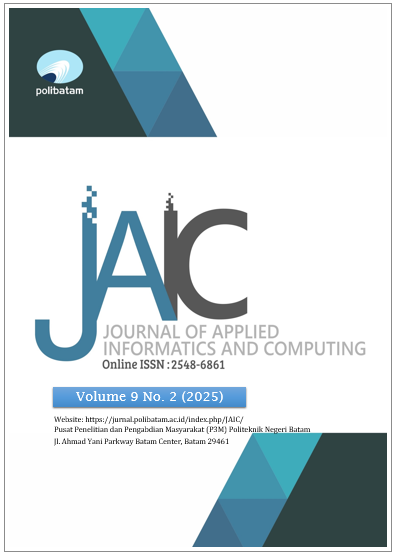Implementation of K-Means Clustering in Grouping Sales Data at Zura Mart
DOI:
https://doi.org/10.30871/jaic.v9i2.9160Keywords:
K-Means Algorithm, Cluster Analysis, Data Mining, Adaptive Marketing StrategyAbstract
The efficiency of inventory management and targeted marketing strategies relies on understanding sales patterns and stock levels dynamically. This study proposes a K-Means Clustering-based approach combined with a real-time stock monitoring system to classify products adaptively. The dataset consists of 87 products with variables including total sales, average sales, and remaining stock. The analysis process begins with data normalization to standardize parameter scales, followed by the application of the Elbow Method, which determines the optimal number of clusters as three. The clustering results indicate that Cluster C0 (21 products) has high sales but low stock, Cluster C1 (59 products) has stable sales with moderate stock, and Cluster C2 (7 products) has low sales but abundant stock. These findings not only provide strategic insights for inventory optimization but also serve as the foundation for developing an automated recommendation system that links clustering results with adaptive promotional strategies and restock prediction. Thus, this study contributes to enhancing Zura Mart's business efficiency through the integration of data-driven decision-making in inventory management and marketing.
Downloads
References
[1] R. Riadi and Mesran, “Penerapan Data Mining Menggunakan Algoritma K-Means Untuk Analisa Penjualan Parfume,” J. Informatics, Electr. Electron. Eng., vol. 2, no. 4, pp. 138–145, 2023, doi: 10.47065/jieee.v2i4.1181.
[2] L. Latifah, M. Yusup, and Supiyandi, “Desain Dan Pembangunan Aplikasi Penjualan Buku Berbasis Website Di Toko Buku Murah Medan,” vol. 9, no. 2, pp. 105–113, 2024.
[3] Asnita, A. Khalid, and A. Salam, “Penerapan Praktik Akuntansi Manajemen Pada UMKM di Kota Makassar,” vol. 7, no. 3, pp. 332–343, 2024.
[4] M. R. Sulistio, N. Suarna, and O. Nurdiawan, “Analisa Penerapan Metode Clustering X-Means Dalam Pengelompokan Penjualan Barang,” J. Teknol. Ilmu Komput., vol. 1, no. 2, pp. 37–42, 2023, doi: 10.56854/jtik.v1i2.49.
[5] W. W. Kristianto, “Penerapan Data Mining Pada Penjualan Produk Menggunakan Metode K-Means Clustering (Studi Kasus Toko Sepatu Kakikaki),” J. Pendidik. Teknol. Inf., vol. 5, no. 2, pp. 90–98, 2022, doi: 10.37792/jukanti.v5i2.547.
[6] R. Mubarok, A. A. Syahputra, A. T. Permana, L. Sholiah, and Tarwoto, “Jurnal JTIK ( Jurnal Teknologi Informasi dan Komunikasi ) Implementasi Data Mining untuk Clustering Lowongan,” vol. 9, no. June, pp. 703–712, 2025.
[7] R. Adha, N. Nurhaliza, U. Sholeha, and M. Mustakim, “Perbandingan Algoritma DBSCAN dan K-Means Clustering untuk Pengelompokan Kasus Covid-19 di Dunia,” SITEKIN J. Sains, Teknol. dan Ind., vol. 18, no. 2, pp. 206–211, 2021, [Online]. Available: https://ejournal.uin-suska.ac.id/index.php/sitekin/article/view/12469
[8] H. Darmawan and N. Yudistira, “Penggunaan Model Tabular Retrieval Model ( TabR ) dengan K-Means Clustering untuk Efisiensi Klasifikasi dan Regresi Data Tabular,” vol. 1, no. 1, pp. 1–9, 2022.
[9] S. Mutiah, Y. Hasnataeni, A. Fitrianto, and L. M. R. D. Jumansyah, “Perbandingan Metode Klastering K-Means dan DBSCAN dalam Identifikasi Kelompok Rumah Tangga Berdasarkan Fasilitas Sosial Ekonomi di Jawa Barat vol. 09, no. September, pp. 247–260, 2024.
[10] M. H. Rifai, D. A. Pramudya, and R. R. Narfandi, “Analisis peran teknologi kecerdasan buatan dalam mengoptimalkan proses deteksi terhadap serangan siber,” pp. 495–502, 2024.
[11] A. P. Adistya, N. Lutfiyani, P. Tara, Rifaldi, R. Adriyan, and P. Rosyani, “Klasterisasi Menggunakan Algoritma K-Means Clustering Untuk Memprediksi Kelulusan Mata Kuliah Mahasiswa,” OKTAL J. Ilmu Komput. dan Sci., vol. 2, no. 8, pp. 2301–2306, 2023.
[12] M. R. Nugroho, I. E. Hendrawan, and P. P. Purwantoro, “Penerapan Algoritma K-Means Untuk Klasterisasi Data Obat Pada Rumah Sakit ASRI,” Nuansa Inform., vol. 16, no. 1, pp. 125–133, 2022, doi: 10.25134/nuansa.v16i1.5294.
[13] S. N. Br Sembiring, H. Winata, and S. Kusnasari, “Pengelompokan Prestasi Siswa Menggunakan Algoritma K-Means,” J. Sist. Inf. Triguna Dharma (JURSI TGD), vol. 1, no. 1, p. 31, 2022, doi: 10.53513/jursi.v1i1.4784.
[14] A. Fikri Sallaby, R. Tri Alinse, V. Novita Sari, and T. Ramadani, “Pengelompokan Barang Menggunakan Metode K-Means Clustering Berdasarkan Hasil PenjualanDi Toko Widya Bengkulu Pengelompokan Barang Menggunakan Metode K-Means Clustering Berdasarkan Hasil Penjualan Di Toko Widya Bengkulu,” J. Media Infotama, vol. 18, no. 1, p. 2022, 2022.
[15] Danya Rizki Chaerunisa, Nining Rahaningsih, Fadhil Muhammad Basysyar, Ade Irma Purnamasari, and Nana Suarna, “Pengelompokan Penjualan Madu Menggunakan Algoritma K-Means,” KOPERTIP J. Ilm. Manaj. Inform. dan Komput., vol. 5, no. 1, pp. 23–28, 2021, doi: 10.32485/kopertip.v5i1.144.
[16] G. Triyandana, L. A. Putri, and Y. Umaidah, “Penerapan Data Mining Pengelompokan Menu Makanan dan Minuman Berdasarkan Tingkat Penjualan Menggunakan Metode K-Means,” J. Appl. Informatics Comput., vol. 6, no. 1, pp. 40–46, 2022, doi: 10.30871/jaic.v6i1.3824.
[17] T. Asy Aria, M. Julkarnain, and F. Hamdani, “KLIK: Kajian Ilmiah Informatika dan Komputer Penerapan Algoritma K-Means Clustering Untuk Data Obat,” Media Online, vol. 4, no. 1, pp. 649–657, 2023, doi: 10.30865/klik.v4i1.1117.
Downloads
Published
How to Cite
Issue
Section
License
Copyright (c) 2025 Miranda ., Sriani .

This work is licensed under a Creative Commons Attribution-ShareAlike 4.0 International License.
Authors who publish with this journal agree to the following terms:
- Authors retain copyright and grant the journal right of first publication with the work simultaneously licensed under a Creative Commons Attribution License (Attribution-ShareAlike 4.0 International (CC BY-SA 4.0) ) that allows others to share the work with an acknowledgement of the work's authorship and initial publication in this journal.
- Authors are able to enter into separate, additional contractual arrangements for the non-exclusive distribution of the journal's published version of the work (e.g., post it to an institutional repository or publish it in a book), with an acknowledgement of its initial publication in this journal.
- Authors are permitted and encouraged to post their work online (e.g., in institutional repositories or on their website) prior to and during the submission process, as it can lead to productive exchanges, as well as earlier and greater citation of published work (See The Effect of Open Access).











